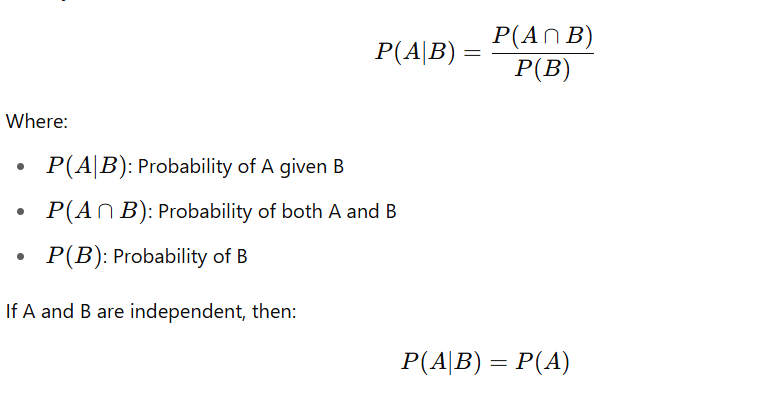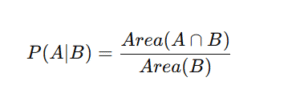Welcome To Our conditional probability calculator
Use this Conditional Probability Calculator to solve P(A|B) with formula, step-by-step explanation, and examples for independent or dependent events.
Conditional Probability Calculator
Table of Contents
Related Calculator:

Conditional Probability Calculator – With Steps, Table, and Examples
Introduction
Understanding conditional probability is essential in statistics and data science. When one event depends on another, calculating probabilities can get complex—but that’s where a Conditional Probability Calculator becomes useful. This tool allows you to calculate conditional probability, even for multiple events, with or without tables or diagrams.
What Is Conditional Probability?
Conditional probability refers to the probability of one event happening given that another event has already occurred. It’s written as:

Why Use a Conditional Probability Calculator?
A conditional probability calculator with steps:
- Saves time on complex manual calculations
- Handles multiple events with accuracy
- Can process fractions, percentages, or decimal probabilities
- Supports visual formats like Venn diagrams, tables, and tree diagrams
How to Use the Conditional Probability Calculator
- Choose your input type: table, fractions, percentages, or decimals
- Enter known values: joint probability P(A∩B), or individual event probabilities
- Choose the type of dependency: independent or dependent events
- Click ‘Calculate’
- View step-by-step explanation and final result
Find Conditional Probability Calculator for Different Use Cases
Conditional Probability Calculator Fractions
If your question uses fractions like:

Conditional Probability Calculator Dice
If rolling two dice, what’s the chance of getting a 4 on the second, given the first was an even number?
- P(B∣A)=P(rolling4 | even number)
- Input outcomes into calculator for exact probability
Multiple Conditional Probability Calculator
For 3 or more events:
P(A∩B∩C)=P(A)⋅P(B∣A)⋅P(C∣A∩B)
Use a conditional probability calculator 3 events or conditional probability calculator 4 events for complex scenarios like genetics, disease prediction, or risk modeling.
Conditional Probability Calculator Table
The table format is helpful in exams and probability distributions.
Example table:
| Event B | Not B | |
|---|---|---|
| A | 20 | 10 |
| Not A | 15 | 55 |
Use a table of conditional probability calculator to find:
- P(A∣B)
- P(B∣A)
- P(A∩B)
Visual Methods to Calculate Conditional Probability
Conditional Probability Calculator Tree Diagram
A tree diagram visually shows multiple stages of events and branches for each outcome. The calculator maps each path and calculates total and conditional probabilities accordingly.
Venn Diagram Conditional Probability Calculator
A Venn diagram calculator shows intersections between events. For overlapping events (dependent), it computes:

Intersection and Conditional Probability Calculator
To find the joint probability:
![]()
This calculator automatically derives the intersection probability if conditional values are known.
Independence and Conditional Probability Calculator
For independent events:
![]()
A specialized calculator checks for independence and verifies whether conditional probabilities match marginal probabilities.
Bayesian Network Conditional Probability Calculator
Bayesian networks help when multiple conditional probabilities depend on one another.
This calculator accepts:
- Prior probabilities
- Conditional tables
- Event dependencies
Useful in:
- Medical testing
- AI/machine learning
- Risk assessment
Conditional Probability Calculator TI-84
For TI-84 users:
- Use the 2nd → VARS → DISTR menu
- Use custom programs or enter probability formulas manually
- Or install preloaded conditional probability programs (from education sites)
While useful, these require calculator-specific knowledge. The web-based version is easier for most students.
Common Mistakes When Using a Conditional Probability Calculator
- Swapping the condition (calculating P(B∣A) when you need P(A∣B)
- Forgetting that P(B) must not be zero
- Treating dependent events as independent
- Misreading table values or interpreting percentages incorrectly
Always double-check input formats and formulas.
Real-World Applications
| Field | Use Case |
|---|---|
| Healthcare | Probability of disease given symptoms |
| Finance | Risk of loss given market trends |
| Education | Test pass rates given study habits |
| Manufacturing | Machine failure given recent usage data |
FAQ – Conditional Probability Calculator
Q1. What is a conditional probability calculator used for?
It calculates the probability of one event occurring given that another event has already occurred. It’s helpful for exams, risk assessments, and data analysis.
Q2. Can this calculator handle multiple events like 3 or 4?
Yes. You can use a conditional probability calculator 3 events or 4 events mode for complex scenarios involving chains of conditions.
Q3. Does it support tables and Venn diagrams?
Yes. Many tools include table input or diagram-based explanations for visual learners.
Q4. Can I use this calculator with fractions and dice examples?
Absolutely. The calculator supports fractions, percentages, and events involving dice or cards.
Q5. Is this calculator available for Excel or TI-84?
Yes. You can build one in Excel or use the TI-84 with basic formulas, though online versions are faster and more flexible.
Conclusion
A Conditional Probability Calculator is a powerful tool for solving problems involving dependent or sequential events. Whether you’re calculating with tables, fractions, Venn diagrams, or tree structures, this tool helps avoid manual errors and speeds up analysis. It’s especially helpful when dealing with multiple conditional events, whether in academics, research, or real-world applications.
With step-by-step explanations and visual aids, this calculator ensures accuracy and clarity. Try it today to explore conditional probability in a simpler, smarter way.
Disclaimer
This calculator is designed for educational and informational purposes only. While it provides accurate results based on standard formulas, it should not be used for legal, financial, or professional decisions without expert consultation. Always validate your results with additional sources when necessary.